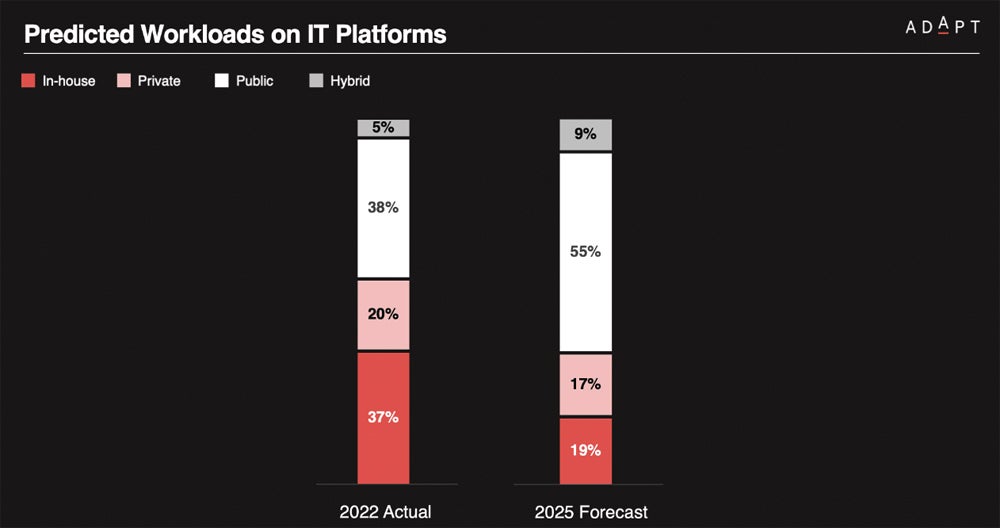Cloud computing will account for 70% of global enterprise workloads by 2028, up from about 25% now, according to Gartner, and issues like sustainability, AI computing and data sovereignty will play greater roles in how Australian enterprises use and procure cloud vendors.
At the Gartner IT infrastructure, Operations & Cloud Strategies Conference in Sydney, Dennis Smith, a leading cloud computing analyst, told Australian cloud computing executives the cloud had moved from being a technology disrupter to a business disrupter and was now becoming a business essential.
“If you don’t have a cloud strategy that’s solid and aren’t executing on it, you’re going to be putting your business at risk in many ways,” he said. “We’ve gone beyond this being a thing you’re kind of dabbling with to really something that needs to be a part of your much larger IT strategy.”
Gartner’s seven cloud computing trend predictions for Australia and globally until 2028 were:
More than half of current multicloud plans will fail to provide value by 2028.
Cloud-native platforms will be the de facto way of implementing new applications.
Cloud modernisation will see 70% of workloads in cloud environments by 2028.
Industry clouds will be used by more than half of all organisations in the cloud.
Multinationals will need to have a digital sovereignty strategy by 2028.
Sustainability will become a top five procurement criterion for cloud vendors.
AI and machine learning will account for 50% of cloud computing by 2028.
In additional research published to coincide with the Australian cloud conference, Gartner predicted Australian companies would spend AUD $23.3 billion (US $15.4 billion) on public cloud in 2024, up 19.7% from 2023. Spending on software-as-a-service will continue to be the largest category, up 18.3% in 2023 to AUD $11 billion (US $7.2 billion) in spending.
1. More than half of current multicloud plans will fail to provide value by 2028
Multicloud strategies are a top agenda item for clients in 2024, Smith said. However, while saying multicloud was not inherently a bad strategy, 50% or more organisations would not gain the value they were seeking by 2028, often because “they are not always doing multicloud for the right reasons.”
Smith said multicloud did not always provide portability or resilience if applications themselves are not architected and encoded for those advantages. Multicloud may not be cheaper if customers have less price leverage with a cloud vendor or need to spend on talent and tooling to manage the environments.
2. Cloud-native platforms to become the de facto way of implementing new applications
Gartner believes cloud-native platforms will be the default for building new applications by 2028, whether in the public cloud or in on-prem or hybrid environments. Smith described cloud-native as those platforms “enabling developers to get up to speed and develop code quicker.”
“Think of the ability to build applications that are scalable, that are instrumented already, that have a nice tight CI/CD (continuous integration and deployment) pipeline, that give the ability to implement some serverless functions. Maybe a managed Kubernetes offering or other activity that makes it easier for me as a developer to code that application,” he said.
3. Cloud modernisation will see 70% of Australian and global workloads in cloud environments by 2028
Gartner said the focus on modernisation from enterprises and cloud providers, as well as new emerging AI tools for modernisation such as tools discovering legacy systems or refactoring notes, will see a dramatic shift in the proportion of workloads in the cloud, from 25% to 70%.
SEE: The top five advantages of cloud computing.
Australian research firm ADAPT has found highly modernised organisations in Australia already have 67% of their workloads in public clouds and predicted that 55% of workloads overall will be in public clouds by 2025, with larger organisations in particular more committed to cloud strategies. Hyperscalers like Microsoft have been investing in new cloud capacity.
 Australian organisations are predicted to home 55% of their workloads in public clouds by 2025. Image: ADAPT Research
Australian organisations are predicted to home 55% of their workloads in public clouds by 2025. Image: ADAPT Research
“The remaining will be within your existing data centers and such. A key takeaway is that the future for most of you will be hybrid, so do end up planning for that.” Smith added the blanket concept of organisations just moving everything to the cloud without vetting applications is not the right path to take.
4. More than half of all organisations will accelerate with industry cloud platforms
There is a 50% chance or more, according to Gartner, that organisations will utilise an industry cloud platform by 2028. Smith described industry clouds as a combination of an infrastructure platform and SaaS offering, enabling a company to jump-start initiatives in an industry, like manufacturing or retail.
“There are numerous vendors in this space, including the hyperscalers. So do end up anticipating this, particularly if you’re looking at gaining a competitive advantage within your respective industries,” he told delegates at Gartner’s conference.
5. Digital sovereignty issues will require multinationals to develop strategies by 2028
The multinationals Australian cloud professionals work within will need strategies around digital sovereignty by 2028, Gartner argued. Strategies will aim at having more control over technology, data or operations in national locations, or even having the technology disconnected in some manner.
“This is a very hot area among many of my clients in certain parts of the world, where they may be in countries and a bit hesitant, frankly, to use a cloud provider across the ocean, or may have a fear that there may be some national issues that may cause that to be disconnected,” Smith elaborated.
Australia’s own dependence on tech from the U.S. and China has been noted. The Australian government has admitted dependence on the three U.S. hyperscale clouds and was left stranded when Microsoft pulled out of a project that would have provided a sovereign Australian “top secret” cloud.
6. Sustainability will become one of the top five procurement criteria for cloud vendors
Gartner estimated a quarter of organisations are already asking for sustainability information as part of the procurement process for cloud vendors, with particular interest over the last three years. Smith said that would at least double over the next four years to become a top five criteria.
In 2024, Australia released draft legislation that would introduce mandatory climate-related reporting. These requirements would require reporting from larger companies with more than 500 employees, revenues higher than AUD $500 million (US $331 million) or AUD $5 billion (US $3.3 billion) in assets from the 2024/25 financial year, with medium-size and smaller companies to follow in the next two financial years.
Smith noted some cloud vendors are already having to build data centres in adjacent countries if there are energy consumption restrictions in jurisdictions. He said enterprises in the near future would be asking vendors for more transparency and would need to look at the energy consumption of their own data centres.
7. AI and machine learning will account for 50% of cloud computing resource usage
The amount of cloud computing resources directed to AI and machine learning is about 10% today, but this will increase fivefold, though other activity will not decrease. Smith said the industry would move from a “medium sized pizza to a large pizza,” with 50% dedicated to AI and machine learning.
Gartner VP Analyst Michael Warrilow said generative AI is becoming a key driver and differentiator of future cloud demands. “Australian CIOs must determine the best adoption model for their needs, whether to build a model from scratch, or focus on AI capabilities being integrated into the applications they buy.”
Editor’s note: TechRepublic covered Gartner IT infrastructure, Operations & Cloud Strategies Conference remotely.
>>> Read full article>>>
Copyright for syndicated content belongs to the linked Source : TechRepublic – https://www.techrepublic.com/article/gartner-cloud-computing-predictions-australia/































